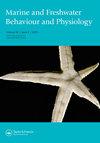Laboratory observations on predator–prey interactions between the bearded fireworm (Hermodice carunculata) and Mediterranean benthic invertebrates
IF 1.1
4区 生物学
Q3 MARINE & FRESHWATER BIOLOGY
Marine and Freshwater Behaviour and Physiology
Pub Date : 2018-05-04
DOI:10.1080/10236244.2018.1502031
引用次数: 13
Abstract
ABSTRACT The bearded fireworm (Hermodice carunculata) is an amphinomid polychaete with a circumtropical Atlantic-Mediterranean distribution. In the Mediterranean Sea, very little information is available on its feeding habits and ecological functions. Here, its increasing abundance and the ability to actively prey on a keystone sea urchin species suggest potential repercussions for the structure and functioning of benthic communities. We performed laboratory feeding experiments to investigate interactions between Mediterranean H. carunculata and 12 species of sessile or sedentary invertebrates. H. carunculata preyed efficiently on 9 of the species offered. In particular, active predation of a polychaete upon nudibranchs, colonial ascidians and chitons was reported for the first time. Fireworms’ predatory ability may be due to a combination of several ‘weapons’ (large size, motility, stinging chaetae and eversible, sucking pharynx) which seems to be unique among marine worms, and could enable H. carunculata to persist also after radical changes in prey community composition and withstand selective pressures associated with ongoing environmental changes.长须火虫(Hermodice carunculata)与地中海底栖无脊椎动物之间捕食-猎物相互作用的实验室观察
胡火虫(Hermodice carunculata)是一种分布在大西洋-地中海热带的两栖多毛纲动物。在地中海,关于其食性和生态功能的资料很少。在这里,它不断增加的丰度和积极捕食重要海胆物种的能力表明了对底栖生物群落结构和功能的潜在影响。我们进行了实验室摄食实验,以调查地中海的H. carunculata与12种无根或久坐的无脊椎动物之间的相互作用。小圆齿蝉有效地捕食了其中的9种。其中,多毛纲动物对裸鳃纲、海鞘纲和石纲的主动捕食首次被报道。火虫的掠食能力可能是由于几种“武器”的结合(体型大、能动性强、有刺的毛羽和可弯曲的吸吮咽部),这在海洋蠕虫中似乎是独一无二的,这可能使火虫在猎物群落组成发生根本变化后也能坚持下去,并承受与持续环境变化相关的选择压力。
本文章由计算机程序翻译,如有差异,请以英文原文为准。
求助全文
约1分钟内获得全文
求助全文
来源期刊

Marine and Freshwater Behaviour and Physiology
生物-海洋与淡水生物学
CiteScore
2.10
自引率
0.00%
发文量
9
审稿时长
>12 weeks
期刊介绍:
Marine and Freshwater Behaviour and Physiology is devoted to the publication of papers covering field and laboratory research into all aspects of the behaviour and physiology of all marine and freshwater animals within the contexts of ecology, evolution and conservation.
As the living resources of the world’s oceans, rivers and lakes are attracting increasing attention as food sources for humans and for their role in global ecology, the journal will also publish the results of research in the areas of fisheries biology and technology where the behaviour and physiology described have clear links to the contexts mentioned above.
The journal will accept for publication Research Articles, Reviews, Rapid Communications and Technical Notes (see Instructions for authors for details). In addition, Editorials, Opinions and Book Reviews (invited and suggested) will also occasionally be published. Suggestions to the Editor-In-Chief for Special Issues are encouraged and will be considered on an ad hoc basis.
With the goal of supporting early career researchers, the journal particularly invites submissions from graduate students and post-doctoral researchers. In addition to recognising the time constraints and logistical limitations their research often faces, and their particular need for a prompt review process, accepted articles by such researchers will be given prominence within the journal (see Instructions for authors for details).
 求助内容:
求助内容: 应助结果提醒方式:
应助结果提醒方式:


